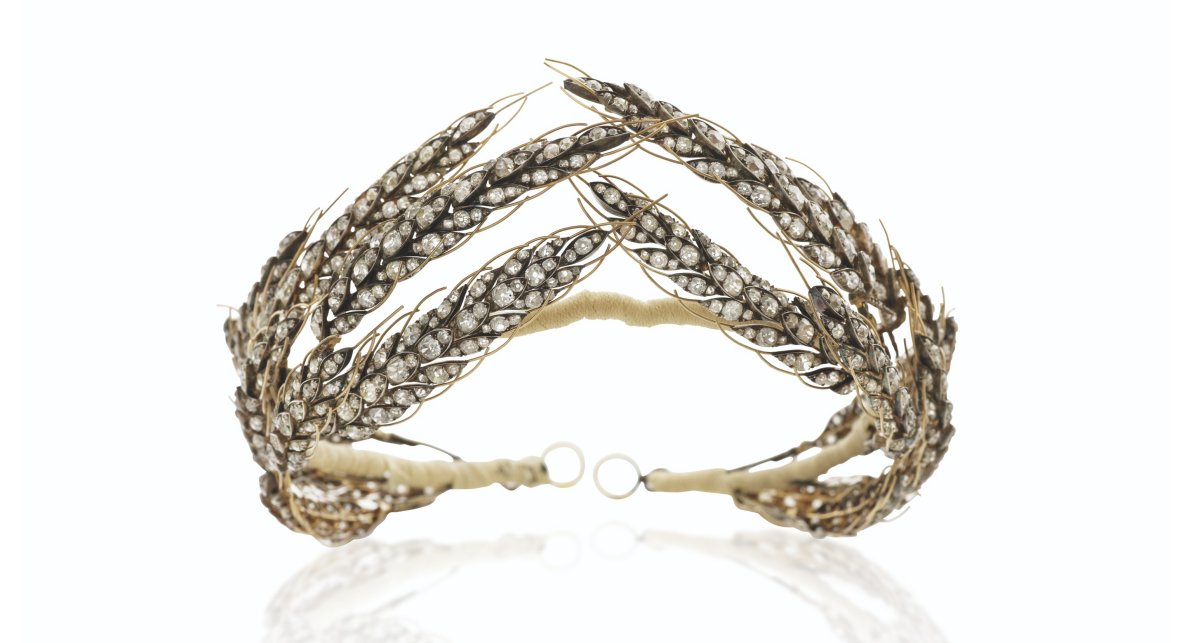
Didn’t I tell you that the upcoming Magnificent Jewels sale at Christie’s in Geneva is shaping up to be a landmark royal jewel auction? We’re just getting started, it turns out. Details have been published about the first lot in the sale, and it’s a doozy. Here’s everything we know about the French imperial tiara headed for the auction block.

The tiara is a rare example of a surviving jewel from the Napoleonic era. The piece, which is constructed with an ears of wheat design, is made of gold and silver and set with old-cut diamonds. Known as “épis de blés” in French, ears of wheat were a prominent and important design element during the Empire period, linked to the neo-classical aesthetic so beloved by Napoleon and his court.

According to the lot notes from Christie’s, the tiara dates to 1811. It was made by François Regnault Nitot, court jeweler to Napoleon Bonaparte. Nitot, who had succeeded his father in the post, served as Napoleon’s official jeweler until the collapse of the empire in 1815. Then, he sold the business to the firm’s master craftsman, Jean-Baptiste Fossin. Today, the firm still exists under a familiar name: Chaumet.

Like so many ears of wheat tiaras, this one can be worn in various configurations with different numbers of “ears.” This image from Christie’s shows eighteen distinct ears of wheat ornaments. The individual “ears” could also be worn as brooches.

Nitot didn’t just make jewels for Napoleon and his two wives. The workshop also produced incredible pieces for members of the extended family. Christie’s states that the ears of wheat tiara belonged to Napoleon’s sister, Pauline Bonaparte (1780-1825). She was married first to one of Napoleon’s generals, Charles Leclerc, with whom she had a son, Dermide. After Leclerc’s death in 1802, Napoleon arranged for her to marry Camillo Borghese, an Italian prince.

Pauline is one of the women featured in Jean-Louis David’s famous painting of Napoleon and Josephine’s 1804 coronation, which took place at the Cathedral of Notre Dame in Paris.

Here’s a detail that shows Pauline in the painting more clearly. The women in order from left to right, are Elisa Bonaparte Baciocchi (sister of Napoleon), Pauline Bonaparte Borghese (sister of Napoleon), Caroline Bonaparte Murat (sister of Napoleon), Hortense de Beauharnais Bonaparte (daughter of Josephine and sister-in-law of Napoleon), and Julie Clary Bonaparte (sister-in-law of Napoleon). The little boy clutching Hortense’s hand is her eldest son, Napoléon Louis Charles Bonaparte.
You’ll note that Pauline, second from the left, is wearing a diamond ears of wheat tiara in the painting. The lot notes clock this as well: “Pauline Borghese can be spotted wearing a wheat sheaf tiara.” But they don’t claim that it’s the same tiara as the one being sold. It couldn’t be: the coronation took place in December 1804, the painting was finished in 1807, and the tiara being sold at Christie’s dates to 1811.

Pauline is a fascinating and complex figure from the Napoleonic world. Sometimes at odds with her brother, she ended up being one of his greatest supporters at the end of his life. Her only son, Dermide, died in 1804. She and Camillo Borghese, who were separated for a great deal of their marriage, had no descendants. But the tiara, according to Christie’s, has remained in the family since Pauline’s death in 1825.
The range of images shared by the auction house includes a black-and-white photo of a woman, dating to the first half of the twentieth century, wearing the tiara (plus several additional wheat ornaments on her dress). She’s identified as Maria Immacolata Salviati, the wife of Giacomo Salviati. Giacomo is a direct descendant of Francesco Borghese, Camillo Borghese’s younger brother. The tiara, it turns out, has been in the extended Borghese family since Pauline’s death.

The tiara will be auctioned in Geneva on November 9, along with several other glittering royal jewels (including Marie Antoinette’s diamond bracelets and the Duchess of Windsor’s ruby bangle). The current auction estimate for the piece is set at between 440,000-650,000 Swiss francs. (That’s approximately $476,000-704,000 USD.) Here’s hoping this one is snapped up by a museum—it’s certainly a historical piece worth displaying!
Leave a Reply
You must be logged in to post a comment.